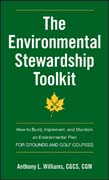
The environmental stewardship toolkit: how to build, implement and maintain an environmental plan for grounds and golf courses
Williams, Anthony L.
This work supplies the single source guide to the environmental management, resource management, community engagement, and documentation management of golfcourses and grounds. With detailed coverage of site assessment, water qualityand conservation, wildlife habitat management, IPM, and resource conservation, this book offers guidance and customizable implementation plans from a leading golf course superintendent and grounds manager. Illustrations, photos, and sample documents throughout allow readers to visualize what's explained in thetext, and then implement it using templates provided. INDICE: Foreword xiAcknowledgments xiiiSECTION 1 Environmental Management 1Chapter 1: Building a Green Team 3How to Establish an Environmental Committee3Where Do You Look to Begin Filling Positions in Your Committee? 4How Many People Should Be on Your Environmental Committee? 9Summary 10Chapter 2: The Environmental Plan: Site Assessment 11The Site Assessment 12Site Assessment Features for Golf Courses 16Summary 17Chapter 3: The Environmental Plan: Agronomic Programs 19Soil Structure and Edaphology 19Essential Elements to “All†Plant Growth 21Soil Samples and Soil Testing 23Tissue Samples 25Cultural Practicesfor Turf 26What Is a Carbon Footprint and Why Is It Mentioned Here? 33Summary35Chapter 4: The Environmental Plan: Water Quality and Conservation 37Water Basics 37Water Quality Programs and Strategies 38Summary 53Chapter 5: The Environmental Plan: Wildlife and Habitat Management 55Developing a Wildlife Inventory 55Guidelines for Enhancing and Maintaining Wildlife Habitat 64Summary 66Chapter 6: The Environmental Plan: Integrated Pest Management 67Protecting Agronomic Assets through IPM 67Summary 82Section One: Environmental Management Conclusions 82Action Steps: Green, Greener, Greenest 83SECTION 2 Resource Management 85Chapter 7: Accounting and Financial Processes 87The Accounting Equation 88Specifi c Financial Documents 89Using Comparative Reports 94Summary 98Chapter 8: Budget Reduction and Contingency Strategies 99Environmental Programs That Cut Expenses and Protect Assets 99Partnerships Increase The Effectiveness of Recycling Programs 104Summary 114Chapter 9: Human Resources Management 115Employee Recruitment and Hiring Practices 116Achieving More with Less 121Safety Programs and Resource Management 122Summary 129Section Two: Resource Management Conclusions 132Action Steps: Green, Greener, Greenest 132SECTION 3 Environomic Community Engagement and Green Public Relations 135Chapter 10: Environomic Community Engagement 137The Role of the Green Industry Professional in an EnvironomicCommunity Engagement Program 138Simple Steps for Starting an Environomic Community Engagement Program 139Summary 144Chapter 11: Public Relations and the Green Industry Professional 145Communicating to and with Target Audiences 145Public Relations and the Green Industry Professional 148Creating a “Beyond the Property†Program 150Crafting Your Story 152Ten Steps to Creating and Sustaining a Successful Beyond the Property Public Relations Program 155Summary 156Chapter 12: Photography’s Role in Green Public Relations 157Digital Camera Facts for the Green Industry Professional 160Learning Another Language (or Two) 171The Future of Community Engagement 173Summary 174Section Three: Environomic Community Engagement And Green Public Relations Conclusions 174Action Steps: Green, Greener, Greenest 174SECTION 4 Documentation Management 177Chapter 13: Essential Green Industry Documentation 179How Do I Begin to Create a Personal Documentation List? 180Transforming Your Personal Documentation List into a Personal Documentation Program 182Documentation: Tools of the Trade 184The Daily Work Log 185Weather Reports 188Agronomic Reports and Documentation 191WaterQuality Tests 193Disease and Nematode Sampling 195Chemical Application Records 195The Right to Know Center and Safety Training Documents 198Licenses and Miscellaneous Documents 202Summary 202Chapter 14: Case Study Documentation and Uses 203What Exactly Does a Case Study Look Like? 204Environmentally Focused Documentation: the Building Blocks of Case Studies 216Water Use and Irrigation Documents 219Summary 221Section Four: Documentation Management Conclusions 221Action Steps: Green, Greener, Greenest 222SECTION 5 Putting It All Together: Synergy and the Green Industry Professional 223Chapter 15: Career Focus and Professional Image 225Time Horizons, Career Focus and the Green Industry Professional 231Stretch Goals and Link Goals 238Summary 244Chapter 16: Professional Associations and Networking 245American Nursery and Landscape Association 246American Society of Golf Course Architects 246American Society of Landscape Architects 247Golf Course Builders Association of America 247Golf Course Superintendents Association of America 248Irrigation Association 248International Societyof Arboriculture 249Professional Grounds Management Society 249Professional Landcare Network (PLANET) 250Sports Turf Managers Association 251The Green Industry Ambassador 251Summary 255Chapter 17: Roadmaps for Success—Personal Success Stories from the Green Industry 257Delany, Tom 258Dinelli, F. Dan 260Farren, Bob 265Finney, Shelia 267Hiers, Tim 269Higgins, Monica 272Jackson, Joseph B. 275Maples, Palmer Jr. 277Mangum, Ken 279Mongeon, Roger 281Newell, Ellen 282O’Donnell, Kevin 284Phipps, David 285Pinson, Bob 288Scott, Bob 289Toma, George P. 291Van Etten, John 292Van Haasteren, George 294Williams, Bruce R. 296Summary 298Section Five: Synergy and the Green Industry Professional Conclusions 298Action Steps: Green, Greener, Greenest 299Index 301
- ISBN: 978-0-470-63516-2
- Editorial: John Wiley & Sons
- Encuadernacion: Rústica
- Páginas: 320
- Fecha Publicación: 23/03/2012
- Nº Volúmenes: 1
- Idioma: Inglés
